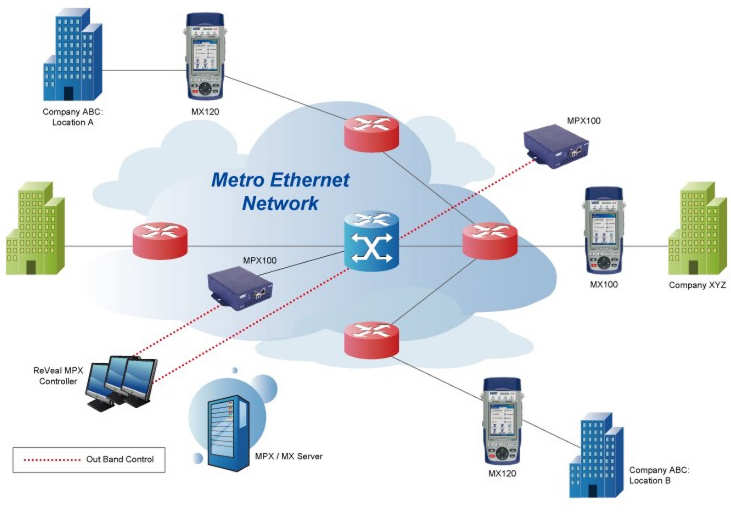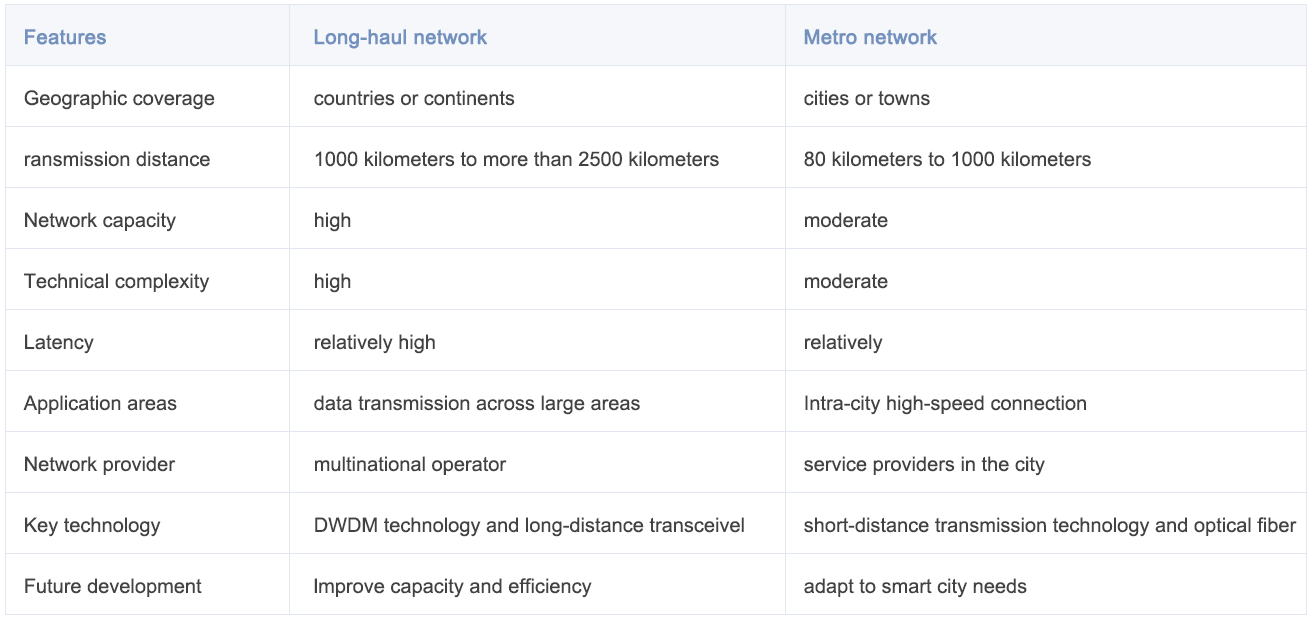As the IoT booms, so does the number of network-connected devices. According to the latest IoT Analytics report, the number of connected IoT devices worldwide is expected to grow to 16.7 billion active endpoints by the end of 2023. This has made the world more connected than ever before. In the era of global interconnection, organizations, businesses, and individuals are increasingly dependent on stable and high-speed data transmission. The long-haul and metro networks are the core that supports the Internet of Everything.
Long-haul networks and metro networks are two important types of networks, which respectively serve different geographical areas and usage scenarios. Long-distance networks are mainly used to connect geographically separated places such as countries. Metro networks, on the other hand, are primarily used for smaller geographic areas, such as cities or urban agglomerations. There are many similarities in how the two networks are designed and operated, but there are also many key differences.
Long-haul network
It is a bridge to the world. A long-haul network is a communication network that covers a wide geographical area, often connecting different cities, countries, and even continents. The design and implementation of long-haul networks need to take into account many special factors, including the need for long-distance transmission, network stability and reliability, and the need for redundancy. Long-haul networks typically use high-speed fiber optic networks to ensure that data travels from one place to another quickly and accurately.

1.1 Advantages of long-haul network
Broad coverage: Long-haul networks can cover a wide geographical area and can connect to any network in the world.
High-speed transmission: The use of optical fiber networks can achieve high-speed data transmission, ensuring fast response even across oceans.
High reliability: Long-haul networks are usually with redundant designs to ensure that even if some parts have problems, the overall network can still operate.
1.2 Disadvantages of long-haul networks
High cost: Due to its wide coverage and the need for a large amount of equipment and personnel maintenance, the construction and operation costs of long-hual networks are relatively high.
Latency: Despite the use of high-speed fiber optic networks, delays in long-haul networks are still unavoidable due to geographical distance constraints.
Metro network
It’s the ties within the city. A metro network, also known as a metropolitan area network or MAN, refers to a network covering a city or region. It is commonly used to connect various places within a city, such as offices, schools, hospitals, and homes. The design and implementation of the metropolitan area network needs to take into account many special factors, including short-distance transmission, network stability and reliability, and localization requirements.

2.1 Advantages of metro network
Partial coverage: The metro network mainly covers a city or region, which can carry out fine-grained management of local network requirements.
Low latency: Metro networks typically have lower latency than long-haul networks due to their relatively small geographic reach.
Lower maintenance costs: Due to the smaller coverage area, maintenance costs of metro networks are lower.
2.2 Disadvantages of metro network
Limited coverage: Metro networks have limited coverage as they mainly serve local areas.
Difficulty in scaling: Metro networks may require extensive network reconfiguration if they need to expand to a larger geographic area.
Comparison
3.1 Geographic coverage and transmission distance
Long-haul network: As the name suggests, long-haul networks focus on connecting distant geographic areas, often spanning countries, continents, or even the globe. Its design goal is to achieve data transmission in a large area, and the transmission distance is relatively long, usually between 1000 kilometers and 2500 kilometers. Long-haul networks need to cross various geographical barriers and national borders, so they need to have a high degree of stability and reliability.
Metro networks provide high-speed connections within smaller geographical areas, usually covering cities and towns. Their transmission distance is relatively short, generally between 80 kilometers and 1,000 kilometers. The metro network is dedicated to meeting the communication needs within the city, enabling rapid connection and data transmission to various locations within the city.
3.2 Network capacity
Long-haul networks have higher network capacity, which means they are able to transmit larger amounts of data in a given time. This high capacity is key for long-haul networks to handle large areas and high volumes of data traffic. Long-haul networks use dense wavelength division multiplexing (DWDM) technology, which multiplexes different wavelengths of light by transmitting multiple lights on a single optical fiber. This enables long-haul networks to transmit multiple data streams simultaneously on the same fiber, each using a different wavelength of light, making for extremely high transmission capacity.
Metro networks have lower network capacity than long-haul networks but are still able to handle a significant amount of data traffic. Metro networks can also use DWDM technology, but generally do not require the high capacity of long-haul networks.
3.3 Technology and Application
Long-haul networks typically need more complex technology and equipment to handle communication across large areas. The long-distance transceivers and optical fibers used need to have higher performance and adaptability to maintain stable and reliable transmission. This high technical requirement makes the construction and maintenance of long-haul networks relatively complex.
Metro network: Metro networks focus more on connections within cities, so their technical requirements are relatively low. However, with the digital transformation and intelligent construction within the city, the metro network also needs to adapt to emerging application requirements, such as intelligent transportation and smart city.
3.4 Latency
Long-haul network: The latency of long-haul networks is relatively high, because they usually cross a large geographic area, and data needs to traverse more relay stations and optical fibers. Although the speed of light in a vacuum is constant, it decelerates as it travels through fiber optics, which increases the time it takes for a signal to travel, which in turn increases latency.
Another factor that affects long-haul network latency is the propagation time of the signal. Even though the speed of light is very fast, the travel time becomes noticeable when traveling over long distances. The time it takes for data to travel back and forth across the fiber can greatly intensify network latency.
In contrast, metro networks typically have lower latency. This is because the metropolitan area network covers a smaller geographical area, and the data transmission distance is shorter. The relatively short transmission distance results in shorter data transfer times, which reduces latency. In addition, metro networks usually use more advanced network technologies and equipment, such as high-speed optical fibers and short-distance transmission technologies, which further reduce latency.

Conclusion
Long-haul networks and metro networks have their unique roles and values in different network requirements and scenarios. Whether it is a wide-ranging long-distance network or a local elaborate metropolitan area network, they all play an important role in supporting the development of modern society, business and technology. In the future, as technology develops, both networks will continue to be optimized to meet growing network demands.
Because of its wide coverage, long-haul networks can provide high-speed, efficient network services connecting different geographical locations. However, its high cost and potential latency are challenges that require attention and resolution. In contrast, although the coverage of the metropolitan area network is limited, due to its relatively concentrated geographical location, it can provide network services with lower latency, and the maintenance cost is relatively low.
It is crucial for network service providers to understand the characteristics, advantages and disadvantages of these two networks and to select and design based on actual needs. At the same time, with the development of new technologies such as cloud computing, big data, and the Internet of Things, it is an important direction for future network development to better utilize and integrate these two networks to provide more efficient, flexible, and reliable network services.
Long-haul networks and metro networks are both important components of the global Internet, and their development and optimization will directly affect the performance and service quality of the Internet. In the future network development, it will be both a challenge and an opportunity we face to better utilize and integrate these two networks.



























